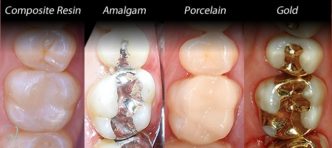Best Dental Fillings Treatement in Vishakapatnam
Dental filling is a most common treatment procedure in Dentistry carried out to treat tooth cavity or tooth decay.
To treat a cavity dentist will remove the decayed portion of the tooth and then fill the area on the tooth where the decayed material was removed.
Dental Fillings are also used to repair cracked or broken teeth.

WHAT IS THE PROCEDURE OF DENTAL FILLING?
Dental Fillings is normally required if your tooth is decayed. It can prevent further damage and can protect your tooth.
- The first step in this process is to see how severe the infected tooth is. This is because Dental Filling is only suitable for decay involving only enamel and dentin layers of tooth.
- The dentist examines the tooth and if required an Dental X-ray of particular tooth would be done for precise information.
- Then the decayed or damaged tooth or teeth and the areas around it is prepared for restoration
- If the tooth is damaged, then a dental handpiece or a laser can be used to remove the damaged part
- A filling is then applied to the area to fill the cavity. The type of filling will depend upon case to case and person to person
- Finally, the finishing and polishing of a Dental filling is done to resemble natural tooth anatomy.
Types of filling materials available?
Several dental filling materials are available in present days. Teeth can be filled with gold, porcelain; silver amalgam (which consists of mercury mixed with silver, tin, zinc, and copper), or tooth-colored and materials called composite resin fillings. also a material that contains glass particles and is known as glass ionomer. This material is used in ways similar to the use of composite resin fillings.
Silver Fillings (Amalgams)
Advantages of Silver Fillings:
- Durability — silver fillings last at least 10 to 15 years and usually outlasts composite (tooth-colored) fillings.
- Strength — can withstand chewing forces
- Expense — may be less expensive than composite fillings
Disadvantages of silver fillings:
- Poor aesthetics — silver fillings don’t match the color of natural teeth.
- Destruction of more tooth structure — healthy parts of the tooth must often be removed to make a space large enough to hold the amalgam filling.
- Discoloration — amalgam fillings can create a grayish hue to the surrounding tooth structure.
- Cracks and fractures although all teeth expand and contract in the presence of hot and cold liquids, which ultimately can cause the tooth to crack or fracture, amalgam material — in comparison with other filling materials — may experience a wider degree of expansion and contraction and lead to a higher incidence of cracks and fractures
- Allergic reactions — a small percentage of people, approximately 1%, are allergic to the mercury present in amalgam restorations.
Advantages of Composites:
- Aesthetics — the shade/color of the composite fillings can be closely matched to the color of existing teeth. Composites are particularly well suited for use in front teeth or visible parts of teeth.
- Bonding to tooth structure — composite fillings micro-mechanically bond to tooth structure, providing further support.
- Versatility — in addition to use as a filling material for decay, composite fillings can also be used to repair chipped, broken, or worn teeth.
- Tooth-sparing preparation — sometimes less tooth structure needs to be removed compared with amalgam fillings when removing decay and preparing for the filling.
Disadvantages of Composites:
- Lack of durability — composite fillings wear out sooner than amalgam fillings (lasting at least five years compared with at least 10 to 15 for amalgams); in addition, they may not last as long as amalgam fillings under the pressure of chewing and particularly if used for large cavities.
- Increased chair time — because of the process to apply the composite material, these fillings can take up to 20 minutes longer than amalgam fillings to place.
- Additional visits — if composites are used for inlays or onlays, more than one office visit may be required.
- Chipping — depending on location, composite materials can chip off the tooth.
- Expense — composite fillings can cost up to twice the cost of amalgam fillings.
Glass ionomer Cement:
Glass Ionomer is made of acrylic and a specific type of glass material. This material is most commonly used for fillings below the gum line and for fillings in young children (drilling is still required). Glass ionomers release fluoride, which can help protect the tooth from further decay. However, this material is weaker than composite resin and is more susceptible to wear and prone to fracture. Glass ionomer generally lasts five years or less with costs comparable to composite resin. The newest ones have an even better lifespan and, when placed in appropriate areas. are equal to composites.

